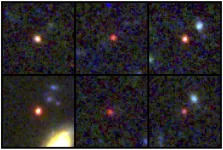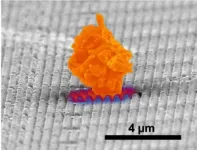(Press-News.org) UNIVERSITY PARK, Pa. — Six massive galaxies discovered in the early universe are upending what scientists previously understood about the origins of galaxies in the universe.
“These objects are way more massive than anyone expected,” said Joel Leja, assistant professor of astronomy and astrophysics at Penn State, who modeled light from these galaxies. “We expected only to find tiny, young, baby galaxies at this point in time, but we’ve discovered galaxies as mature as our own in what was previously understood to be the dawn of the universe.”
Using the first dataset released from NASA's James Webb Space Telescope, the international team of scientists discovered objects as mature as the Milky Way when the universe was only 3% of its current age, about 500-700 million years after the Big Bang. The telescope is equipped with infrared-sensing instruments capable of detecting light that was emitted by the most ancient stars and galaxies. Essentially, the telescope allows scientists to see back in time roughly 13.5 billion years, near the beginning of the universe as we know it, Leja explained.
“This is our first glimpse back this far, so it's important that we keep an open mind about what we are seeing,” Leja said. “While the data indicates they are likely galaxies, I think there is a real possibility that a few of these objects turn out to be obscured supermassive black holes. Regardless, the amount of mass we discovered means that the known mass in stars at this period of our universe is up to 100 times greater than we had previously thought. Even if we cut the sample in half, this is still an astounding change.”
In a paper published today (Feb. 22) in Nature, the researchers show evidence that the six galaxies are far more massive than anyone expected and call into question what scientists previously understood about galaxy formation at the very beginning of the universe.
“The revelation that massive galaxy formation began extremely early in the history of the universe upends what many of us had thought was settled science,” said Leja. “We’ve been informally calling these objects ‘universe breakers’ — and they have been living up to their name so far.”
Leja explained that the galaxies the team discovered are so massive that they are in tension with 99% percent of models for cosmology. Accounting for such a high amount of mass would require either altering the models for cosmology or revising the scientific understanding of galaxy formation in the early universe — that galaxies started as small clouds of stars and dust that gradually grew larger over time. Either scenario requires a fundamental shift in our understanding of how the universe came to be, he added.
“We looked into the very early universe for the first time and had no idea what we were going to find,” Leja said. “It turns out we found something so unexpected it actually creates problems for science. It calls the whole picture of early galaxy formation into question.”
On July 12, NASA released the first full-color images and spectroscopic data from the James Webb Space Telescope. The largest infrared telescope in space, Webb was designed to see the genesis of the cosmos, its high resolution allowing it to view objects too old, distant or faint for the Hubble Space Telescope.
“When we got the data, everyone just started diving in and these massive things popped out really fast,” Leja said. “We started doing the modeling and tried to figure out what they were, because they were so big and bright. My first thought was we had made a mistake and we would just find it and move on with our lives. But we have yet to find that mistake, despite a lot of trying.”
Leja explained that one way to confirm the team’s finding and alleviate any remaining concerns would be to take a spectrum image of the massive galaxies. That would provide the team data on the true distances, and also the gasses and other elements that made up the galaxies. The team could then use the data to model a clearer of picture of what the galaxies looked like, and how massive they truly were.
“A spectrum will immediately tell us whether or not these things are real,” Leja said. “It will show us how big they are, how far away they are. What’s funny is we have all these things we hope to learn from James Webb and this was nowhere near the top of the list. We’ve found something we never thought to ask the universe — and it happened way faster than I thought, but here we are.”
The other co-authors on the paper are Elijah Mathews and Bingjie Wang of Penn State, Ivo Labbe of the Swinburne University of Technology, Pieter van Dokkum of Yale University, Erica Nelson of the University of Colorado, Rachel Bezanson of the University of Pittsburgh, Katherine A. Suess of the University of California and Stanford University, Gabriel Brammer of the University of Copenhagen, Katherine Whitaker of the University of Massachusetts and the University of Copenhagen, and Mauro Stefanon of the Universitat de Valencia.
END
Discovery of massive early galaxies defies prior understanding of the universe
2023-02-22
ELSE PRESS RELEASES FROM THIS DATE:
Mechanisms underlying autoimmunity in Down syndrome revealed
2023-02-22
New York, NY (February 22, 2023) – Scientists at the Icahn School of Medicine at Mount Sinai in New York have identified which parts of the immune system go awry and contribute to autoimmune diseases in individuals with Down syndrome. The findings published in the February 22 online issue of Nature [DOI: https://doi.org/10.1038/s41586-023-05736-y].
The work adds to the research team’s findings published in the journal Immunity in October 2022, showing that people with Down syndrome have less frequent but more severe viral infections.
Studying lab specimens from volunteers with Down syndrome, the investigators identified cytokines and a B cell subtype—key ...
Patients identified as frail before surgery less likely to die one year after
2023-02-22
PITTSBURGH, Feb. 22, 2023 – New research published today in JAMA Surgery shows that when frail patients are connected to resources, including conversations with a physician about possible outcomes and help preparing their body for surgery, they are less likely to die one year after surgery.
While age can be an important indicator of a patient’s likelihood of encountering adverse outcomes or complications of surgery, it does not provide a full picture of their health. Frailty considers the patient’s overall well-being, including their physical and cognitive abilities, as well as their body’s ability to recover from surgery.
“Frailty ...
Association of pandemic with unsafe living situations, intimate partner violence among pregnant individuals
2023-02-22
About The Study: This study found an overall increase in unstable and/or unsafe living situations and intimate partner violence (IPV) between January 2019 and December 2020, with a temporary increase associated with the COVID-19 pandemic. It may be useful for emergency response plans to include IPV safeguards for future pandemics. These findings suggest the need for prenatal screening for unsafe and/or unstable living situations and IPV coupled with referral to appropriate support services and preventive ...
Incidence of aggressive end-of-life care among older adults with metastatic cancer in nursing homes and community settings
2023-02-22
About The Study: The results of this study suggest that despite increased emphasis to reduce aggressive end-of-life care in the past several decades, such care remains common among older persons with metastatic cancer and is slightly more prevalent among nursing home residents than their community-dwelling counterparts. Multilevel interventions to decrease aggressive end-of-life care should target the main factors associated with its prevalence, including hospital admissions in the last 30 days of life and in-hospital death.
Authors: Siran M. Koroukian, Ph.D., of the Case Western Reserve University School of Medicine in Cleveland, is the corresponding ...
Rising river temperatures hold important clues about climate and other human impacts
2023-02-22
An improved global understanding of river temperature could provide an important barometer for climate change and other human activities.
River temperature is the fundamental water quality measure that regulates physical, chemical and biological processes in flowing waters and, in turn, impacts ecosystems, human health, and industrial, domestic and recreational uses by people.
In a comment piece in the new journal, Nature Water, researchers led by the University of Birmingham, UK, and Indiana University, USA, have called for an increased ...
Human body proven to predict mealtimes
2023-02-22
The human body can predict the timing of regular meals, according to a new study from the University of Surrey. The research team also found that daily blood glucose rhythms may be driven not only by meal timing but by meal size.
In the first study of its kind, researchers from Surrey, led by Professor Jonathan Johnston, investigated if the human circadian system anticipates large meals. Circadian rhythms/systems are physiological changes, including metabolic, that follow a 24-hour cycle and are usually synchronised to environmental signals, such as light and dark cycles.
Previous ...
James Webb spots super old, massive galaxies that shouldn’t exist
2023-02-22
In a new study, an international team of astrophysicists has discovered several mysterious objects hiding in images from the James Webb Space Telescope: six potential galaxies that emerged so early in the universe’s history and are so massive they should not be possible under current cosmological theory.
Each of the candidate galaxies may have existed at the dawn of the universe roughly 500 to 700 million years after the Big Bang, or more than 13 billion years ago. They’re also gigantic, containing almost as many stars as the modern-day Milky Way Galaxy.
“It’s ...
Climate ‘spiral’ threatens land carbon stores – study
2023-02-22
The world’s forests are losing their ability to absorb carbon due to increasingly ‘unstable’ conditions caused by humans, a landmark study has found.
Dramatic changes to forests, and other habitats that store carbon in plants and soils, are becoming more likely in some regions across Earth, with less carbon consistently absorbed by the ‘land carbon sink’ provided by trees, soil and plants, according to scientists writing in Nature.
The short-term impacts of rising temperatures, ...
Anti-dust tech paves way for self-cleaning surfaces
2023-02-22
Dust is a common fact of life, and it's more than just a daily nuisance – it can get into machinery and equipment, causing loss of efficiency or breakdowns.
Researchers at The University of Texas at Austin partnered with North Carolina-based company Smart Material Solutions Inc. to develop a new method to keep dust from sticking to surfaces. The result is the ability to make many types of materials dust resistant, from spacecraft to solar panels to household windows.
The research is published in ACS Applied Materials & Interfaces.
"What we've ...
Today’s pediatric heart transplantations involve sicker children, but have better outcomes
2023-02-22
Key takeaways
Heart transplants offered to more patients with serious disease: A study of 323 pediatric heart transplants over 36 years at the University of Florida found that in recent years, more infants with serious congenital heart disease were offered heart transplants, but they had improved outcomes compared to patients in previous decades.
Improved long-term survival: Despite extending the procedure to younger patients with more serious heart problems, 5-year survival improved from 70.7% in previous years to 83% in recent ...



